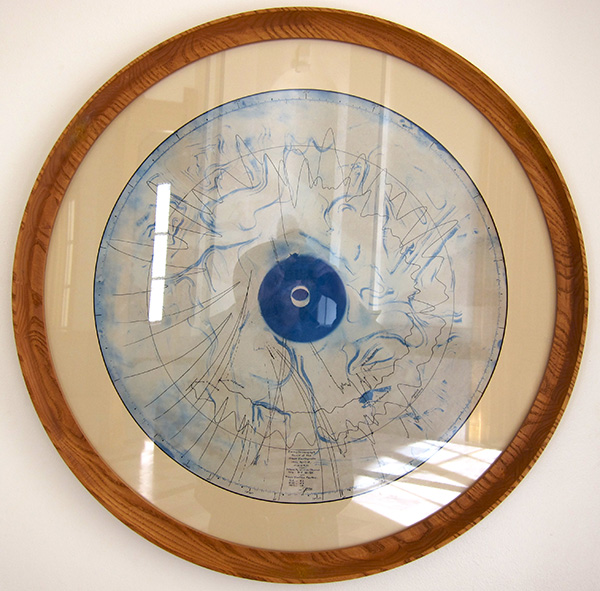About ten days ago, on May 3, 2010, I did a post, “SF and Quantum Mechanics #1,” and today’s post is the follow-up. Although there really are a zillion things one might talk about in this context, in these two posts I’m focusing on six areas. I went into (1) – (3) in my SF & QM #1 post, and in the fairly extensive and interactive comments—these discussions involved possible SF stories involving (1) the Planck length, (2) many universes, and (3) superposed states. And now, in “SF & QM #2,” I’ll tackle topics (4)-(6).

[Slime is health. A ditch near Alviso, CA.]
So onward with my ramshackle QM rap. Harrumph. Today we’ll address these topics:
(4) The Secret Theory. Can there be hidden variables and a deterministic theory at a deeper level than QM?
(5) QM Teep. The QM notion of entanglement says that distant particles’ states are in some instantaneous way correlated.
(6) Everything’s Alive. Quantum computation indicates that any piece of matter can be regarded as a supercomputer, potentially capable of carrying out intelligent-seeming computations.

[My sage friend Gunnar and a relativistic train.]
(4) The Secret Theory.
To some of us it seems annoying that QM only gives a probabilistic prediction of what happens when you measure some given quantity. We’d like to think that there might be some so-called hidden variables at a deeper level, and a richer theory involving these hidden variable which would in fact give completely accurate and deterministic predictions.
QM has several defenses against this hope, in particular the celebrated experimental work involving “Bell’s Theorem,” seems to show that no theory of local hidden variables can correctly match up with the observed results of quantum mechanics.
One way out is to assume there is some kind of global, all-pervasive set of “hidden” or underlying variables. As I put it in a post back in December 10, 2004, “What is Reality? Two CAs,” , it is possible to have “a deterministic universe despite the wifty, come-drink-the-Kool-Aid mystery-mongering of quantum mechanics.”

You must have to suppose that there is an underlying reality which is utterly deterministic both forwards and backwards in time. The scientist Stephen Wolfram had, for a time, some hope of finding the underlying final theory for such a world. His hope that the theory might be something rather simple, a bit like time-reversible cellular automaton rule. The tricky part is finding (a) the rule and (b) at least one complete “Now” to use as the seed for running forward and backwards. Everything has to be just right.
Although Wolfram seems now to have turned to other things, I don’t find his quest unreasonable. In thinking along these lines, I’m inspired by John Cramer’s“The Transactional Interpretation of Quantum Mechanics”. In Cramer’s physics, the future influences our present every bit as much as does the past. Synchronicity is not an illusion, events really are very tightly knit together.

[The only known recording of the large-scale movements of the earth during the Great Quake in San Francisco, 1906, on display at the Mt. Hamilton Observatory near San Jose, CA.]
In some sense a spacetime like Cramer’s needs to be crafted all at once, and from a vantage point wholly outside of space and time. I sometimes like to interpret Cramer’s theory as meaning that our universe is patterned like a novel, with synchronistic and meaningful correspondences built in. These correspondences establish themselves not by cause-and-effect, from outside of time, from the Pen of the some Author (or Process). Here’s a link to my passage discussing this notion in an online section of my tome, The Lifebox, The Seashell and the Soul.
On the way to creating a properly novelistic universe, a Creator might go through a number of drafts, as I mentioned in my earlier “SF & QM #1” post connection with the notions of multiple universes, and my novel Mathematicians in Love. But it’s just as “likely” to suppose he/she/it/they/we managed to get it right on the first try. If something’s impossibly difficult, doing a few warm-ups isn’t necessarily going to get you all that much closer to success.
A completely different approach to a hidden variables theory is to suppose that there are particles below the Planck length or, even better, to suppose that matter is indeed infinitely divisible. In the “SF & QM, #1” post, I mentioned my online story “Jack and the Aktuals,” in which the characters find a transfinite world universe of “hidden variables” down beneath the Planck length, with ever-smaller size scales to explore.

[Quantum foam washes up on the shores of the salty ponds in the SF Bay just north of the San Ho airport.]
(5) QM Teep.
Whether or not we believe QM to be a final theory, we seem to be stuck with the fact that the states of distant objects are entangled with each other—particularly if the two objects in question have ever spent any quality time together. And, hey, if the superdense yobbity-yob seventeen-septillion-clowns-in-one-VW moments of the early universe aren’t quality time, then what is?

Everything affects everything else! But, as usual, science hastens to throw on cold water—in this case by saying that you can’t use entanglement to send messages. But why should SF writers worry about that kind of buzz-kill? We can always find a work-around. In my story, “Panpsychism Proved,” now online, I used some special kind of quantum dots to promote telepathy, which I often call teep.
In general, I might suppose that I can use quantum entanglement to read a distant friend’s mind because, after all, we two have broken bread together. Left to their own devices, our minds fuzz out and become uncertain, but when one of decides something then, given that we’re entangled, the other one decides the same thing too.

[A Mandelbrot set inside the Rudy Set, you can find it by zooming into the RudyRockets image.]
Turns out this move is too much of a cliché to work in SF today. The people who seriously use quantum entanglement as an explanation for psychic phenomena tend to be working a commercial New Age vein. There’s this phenomenon called “decoherence” that tends to screw up your quantum-entangled connection to your pals. So it’s probably wiser for an SF writer to get telepathy, telekinesis, and teleportation by some other means than by entanglement—unless you’re simply out for a lark, or a short-short smash-and-grab.
I most recently used a quite different explanation for telepathy in my novel Postsingular. Here the world has a “paranormal branespace topology”, meaning that one of the normally rolled-up “vermin dimension,” the eighth dimension in fact, is unrolled, and everyone can think out along it to an attainable point at infinity which serves a global telepathy server. You can read this passage of Postsingular online here.
Ph. D. means “piled high and deep.” Let’s kill this sixer.

[Prof. Rucker with a dried cowpie near Mount Hamilton, east of San Jose.]
(6) Everything’s Alive.
As a fuddy-duddy computer science professor, I used to resist the notion of quantum computation. It sounded so flaky—and may well be hamstrung by the decoherence issue. This said, I eventually came around. As an SF writer, I can’t afford to turn my back on a technology that can turn ordinary matter into an inconceivably powerful computer.
The line that pushed me into the quantum computation camp was when I read a remark that whenever you shine light on something it’s doing a quantum computation. How cool is that?
In a post called “Breaking the Bank of Computation,” on September 21, 2009, I got into it and did a back-of-a-matchbook calculation of just how much computation our universe might do for us, running flat out as a quantum computer. You’d get maybe 10-to-the-229th-power operations per second. A little less than a googol cubed.

The tricky bit of course is figuring out how to program raw matter. As I argued in my “Fundamental Limits to Virtual Reality” post on March 3, 2008, there’s really no reason to disassemble our friendly ordinary matter and turn it into some spurious stuff called “computronium.” Regular matter can compute fine just as it is.
But the input/output is an issue. And this is worth thinking about in SF. In my novels Postsingular and Hylozoic, I went ahead and had ordinary objects carrying out autonomous, emerging, evolving mind-like computations. And, just to get the novel written, I assumed that we’d talk to our wise doo-dads via telepathy. I gave some talks on this under the name “Psipunk,” the last time I was in Japan.

Cast off the chains of QM dogma and crank it up! We’ve barely started…









May 14th, 2010 at 2:49 pm
Most mainstream QM talk focuses only on the Copenhagen interpretation- thanks for not doing that.
Personally I’ve always viewed the Copenhagen school of QM as either “i give up” or an obscene arrogance (“we know everything!”) that science has fallen into in the past. Our stochastic formalisms predict well, especially for large populations (radioactive decay, etc.) but it does not signify the end of the story. Yes, we can get the math to predict… how different is that from working with a rickety Taylor series with a bunch of terms but never knowing the true function it emulates?
The unfortunately named ‘hidden variables’ interpretation leaves the door open for scientific modesty. Just like in the past, there could be tinier stuff that we can’t see. Maybe we’ll learn about it more in the future. Ever think that we’re acting like the guys who named atoms ‘atoms’ because they were supposed to be indivisible?
As a scientist and fan of science fiction, I do not understand how both formally trained scientists and fans of science fiction accept the idea that we “hit the limit.” As an analogy, consider the sci fi school of “we can’t write fiction beyond an AI ‘singularity’.”
-John K
May 21st, 2010 at 12:06 pm
What about teleportation through entanglement on a nanoplanck scale? The concept of sending a million nanosatellites into space is well enough established as a concept. If they’re small enough why not transport them through particle entanglement across the galaxy. They could transmit their data back one planckbyte at a time through the same process and we assemble it here to create a picture of what the find.
Another great concept is opening up at the LHC with the possibility of discovering the Higgs Boson. Some theories suggest that will prove there are other dimensions (Lisa Randall for one) because the Higgs would have crossed over from a further dimension. Fertile ground there for story telling!
May 28th, 2010 at 8:19 pm
More in line with your disapproval of the necessity of computronium, but still related to quantum mechanics: http://www.popsci.com/science/article/2010-05/single-molecule-computes-thousands-times-faster-your-pc